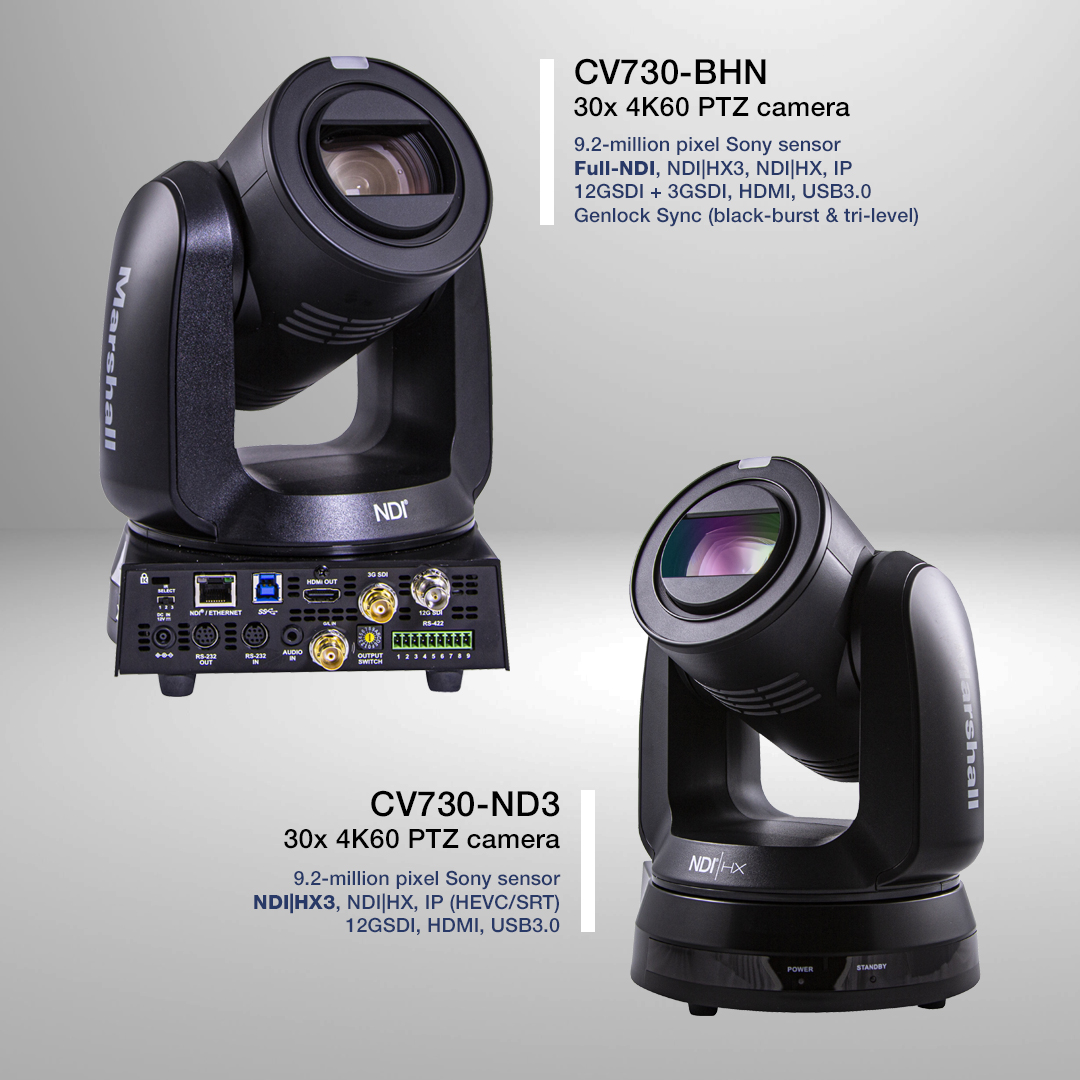2023 NAB Show: Marshall To Feature CV730-BHN and CV730-ND3 Cameras
The 4K60 PTZ cameras with latest Full-NDI and NDI|HX3 technology offer low-latency, high-quality broadcast transmissions

LAS VEGAS—Marshall Electronics, a leading manufacturer of broadcast and proAV cameras and equipment, has announced that it will showcase its CV730-BHN with Full-NDI and CV730-ND3 with NDI|HX3 technology at the 2023 NAB Show in the Central Hall on Booth C5520.
These new cameras are designed to accommodate broadcast production facilities looking to produce high-impact content with less staff on-site and sometimes limited IP bandwidth, the company reported.
The CV730-BHN Full-NDI PTZ camera incorporates the premium Full NDI FPGA while also offering the benefits of NDI|HX3 and standard IP (HEVC/SRT) streams. The CV730-ND3 PTZ camera utilizes the new NDI|HX3 platform and standard IP (HEVC/SRT).
The CV730-BHN features a premium Sony 4K sensor with 9.2 million pixels and back-lit square pixel technology designed behind a long 30x optical zoom range (6.5~ 202mm). It also has support of BT.2020 color gamut for wide and precise color reproduction suitable for high-end productions.
The CV730-BHN has streaming options of Full-NDI, NDI|HX3 and standard IP (HEVC/SRT), while also offering two simultaneous SDI (BNC) outputs 12GSDI + 3GSDI with genlock sync, as well as HDMI and USB3.0 options when the application demands it. High Bandwidth NDI requires higher network bandwidth but in return delivers lowest latency video possible nearing the quickness of traditional SDI, while maintaining premium quality and lossless video performance, the company said.
The CV730-ND3 features a similar Sony 4K sensor with 9.2 million pixels and back-lit square pixel technology designed behind same 30x optical zoom range (6.5~ 202mm). The CV730-ND3 features the new NDI|HX3 premium video codec, and standard IP (HEVC) encoding with SRT, while also offering 12GSDI, HDMI and USB3.0 outputs. The new NDI|HX3 format requires slightly higher bandwidth than previous NDI|HX but much less than is required for Full-NDI. NDI|HX3 delivers similar low latency as Full-NDI at less than 100ms end-to-end and has video quality performance closer to premium Full-NDI quality. NDI|HX3 is a big step forward for NDI|HX while reducing the bandwidth requirements of Full-NDI and delivering similar speeds and video quality, Marshall reported.
“Low latency and lossless video compression are big talking points for broadcasters over the past several years, and we are happy to bring these two new PTZ cameras to market,” says Tod Musgrave, director of cameras for Marshall Electronics. “As one of the first adopters of NDI|HX back in 2018, we’re very excited to refresh all of the NDI|HX models to the new HX3 codecs and launch our first Full-NDI model.”
Get the TV Tech Newsletter
The professional video industry's #1 source for news, trends and product and tech information. Sign up below.
All CV730’s now support a Smart Auto-Focus feature utilizing AI chipsets to target facial features and optimize focus on facial details which improves over time. Marshall PTZ cameras boast a flexible and smooth 340° horizontal pan range with 120° vertical tilt with speed adjustments from slow to fast depending on speed to setup the next shot. This provides a wide range of movement options to content creators when capturing high-quality UHD or HD video. Both cameras are feature rich and fit into a wide range of broadcast and proAV applications requiring low latency streaming with various bandwidth networks. Also included is a PoE++ option for one-cable to camera from PoE switch setup for video, audio, control, power and tally. Customers can choose a Netgear AV over IP switch for easy configuration of Marshall cameras from drop down menus and support for NDI5.5 and beyond.
Both models are available in white and black, with the CV730-BHN shipping by NAB and the CV730-ND3 shipping now.
George Winslow is the senior content producer for TV Tech. He has written about the television, media and technology industries for nearly 30 years for such publications as Broadcasting & Cable, Multichannel News and TV Tech. Over the years, he has edited a number of magazines, including Multichannel News International and World Screen, and moderated panels at such major industry events as NAB and MIP TV. He has published two books and dozens of encyclopedia articles on such subjects as the media, New York City history and economics.

